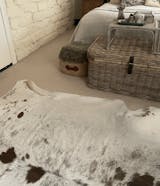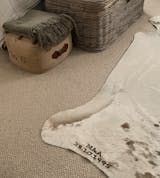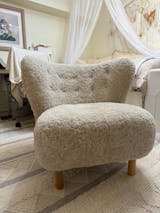
Real Cowhide Rug vs Faux
alicia bengenShare
Real Cowhide Rug vs Faux, why you should buy a real cowhide rug not faux?
Real Cowhide Rug or Faux? When it comes to purchasing a cow print rug, this question is likely on the minds of many buyers.
In recent years, however, synthetic materials have emerged as competitors in various industries, offering alternatives to traditional cowhide products. In this extensive analysis, we will delve into the merits of real cowhide versus synthetic materials, exploring factors such as durability, aesthetics, comfort, environmental sustainability, and cost. Through a combination of research, expert insights, and real-world comparisons, we aim to provide readers with a comprehensive understanding of the value proposition offered by cowhide and its synthetic counterparts.
Before diving into the pros and cons, let’s start with the basics: What exactly is a real cowhide rug, and how does it differ from a faux cowhide rug? Understanding their origins and key features is essential to appreciate their unique qualities and decide which option aligns best with your preferences.
- What is a real cowhide rug?
A real cowhide rug is a stunning natural creation, crafted from the hide of a cow and meticulously processed through tanning to preserve its authentic texture and natural hair. These rugs offer more than just functionality—they bring character, warmth, and a touch of rustic elegance to any space. Known for their distinctive patterns and one-of-a-kind textures, real cowhide rugs seamlessly blend durability with aesthetic appeal, making them a timeless addition to home decor.
To dive deeper into the origins and versatility of cowhide rugs, check out our detailed guide on What is a Cowhide Rug?
- What is faux cowhide rug?
A faux cowhide rug is a synthetic alternative to a real cowhide rug, designed to mimic the appearance and texture of genuine cowhide. These rugs are made from various man-made materials, such as polyester, acrylic, or a blend of synthetic fibers, and are printed with patterns that resemble the natural markings found on real cowhide.
Some faux cowhide materials are crafted from soft fabric, making them ideal for creating cowboy, country decor, and western-themed interiors. These materials are commonly used for items like cow print pants, cowboy shirts, linens, and even decorative accents. They are often cut into shapes resembling cowhide rugs, adding a playful touch to western-inspired spaces.
However, many of these imitation cowhide rugs found in today's market, especially on platforms like Amazon priced at $10-$20 per piece, are extremely thin—more akin to a piece of fabric than a functional rug. While they may work well as decorative throws or light accents, their lack of thickness and durability makes them unsuitable for use as actual rugs in high-traffic areas.
Faux cowhide rug nowadays are getting people's attention for its low cost . But real cowhide is still the first choice for people who really knows about cowhide rug and its value.
For those considering purchasing a faux cowhide rug, take a moment to read this before making your decision:
Cons of Faux Cowhide Rugs
- Lack of Authenticity
Faux cowhide rugs often lack the unique patterns, textures, and luxurious feel of a real cowhide. The synthetic materials used in faux rugs may not capture the natural variations and suppleness of genuine cowhide.
Sadly, we have invested a lot of time and money in taking high-quality pictures of our genuine cowhide rugs, but they are being used on Alibaba and other Chinese websites as catalogs for knock-off faux cowhide rugs. Out of curiosity, we purchased many different qualities of faux cowhide rugs for comparison. The result is clear: genuine cowhide is the winner by far! Imagine this: you take a high-definition picture of a real cowhide rug, input this image into your computer, and print it onto a piece of fabric or polyester pre-cut into a cow shape. This is how faux cowhide rugs are made. Some factories use better ink and higher-definition printers, so the rugs may look better from afar. However, I have seen some cheaply made faux cowhide rugs where the ink is off and the printing is so low quality you can see the pixels of the image.
Genuine cowhide rugs are distinguished by their superior material and natural beauty. Made from real cow skin, these rugs possess a durability and texture that synthetic alternatives cannot replicate. The natural fibers provide a soft, supple feel that is both luxurious and long-lasting. In terms of color and pattern, genuine cowhide rugs offer unique and organic variations, with no two rugs being exactly alike. The natural markings and shades found in real cowhide create a one-of-a-kind piece that adds authenticity and character to any room.
- Shorter Lifespan
The lifespan of a faux cowhide rug can vary significantly depending on the quality of materials and manufacturing processes used. On average, a well-made faux cowhide rug can last anywhere from 3 month to 1 year with regular use.
Higher-quality synthetic materials such as polyester or acrylic, especially those designed to mimic the texture and appearance of real cowhide, can extend the rug's lifespan.
The thinner faux cowhide rugs are like pieces of fabric. They actually use cow-printed material cut into a cow shape and call it a cowhide rug. These are the ones you see on Amazon selling for less than $20. I would call them kitchen towels. Yes, you heard me right—they are as thin and light as kitchen towels! The thicker ones have some weight because they are backed with a rubber-like material, making the rug stand on the floor and feel like an actual rug rather than a piece of fabric. They have a strong ink smell and a mixed plastic smell. After use, your faux cowhide rug will smell like old rubber, and to some people, it smells like a teenager's basketball shoes after practice.

Now the question is:
Is it bad for the environment to buy real cowhide rug?
Environmental Impact of Real Cowhide Vs Faux
Real cowhide: Ethical Considerations
Real cowhide is a byproduct of the meat industry, making it a sustainable choice compared to synthetic materials. Utilizing cowhide in this way helps minimize waste and makes use of the entire animal.
In today's environmentally conscious world, the sustainability of materials is a growing concern for both consumers and manufacturers. Real cowhide offers a compelling case for sustainability, as it is a natural, renewable resource derived as a byproduct of the meat industry. By repurposing cowhide into rugs, upholstery, and accessories, we not only reduce waste but also support a circular economy that minimizes environmental impact.
If you're curious about the ethical sourcing and sustainable practices behind real cowhide rugs, explore our detailed blog on The Ethical Source of Real Cowhide Rugs to gain deeper insights into how these rugs align with eco-friendly values.
Faux Cowhide Rugs: The Imitation Game
Synthetic Materials: Faux cowhide rugs are typically made from polyester or other synthetic fibers. While they can be crafted to look similar to real cowhide, they often lack the depth and richness of natural cowhide patterns.
By repurposing cowhide into rugs, upholstery, and accessories, we can reduce waste and minimize our environmental impact. In contrast, synthetic materials often rely on petrochemicals and other non-renewable resources, contributing to pollution and greenhouse gas emissions. As environmental activist Greta Thunberg once said, "The climate crisis is not just about the environment; it's about justice, human rights, and equality," highlighting the interconnectedness of environmental sustainability and social responsibility.
VOC stands for Volatile Organic Compounds. These are chemicals that easily evaporate at room temperature and are found in a variety of materials, including synthetic rugs, paints, adhesives, cleaning products, and even furniture. VOCs are significant because they can contribute to indoor air pollution and have harmful effects on health and the environment.
How VOCs Relate to Faux Cowhide Rugs:
- Synthetic Materials: Faux cowhide rugs, often made from polyester, PVC, or other plastics, may release VOCs into the air. This process, known as off-gassing, can lead to poor indoor air quality.
- Health Concerns: Exposure to VOCs can cause headaches, dizziness, respiratory issues, and other health problems, particularly for individuals with sensitivities or allergies.
- Environmental Impact: The production of VOC-emitting materials relies on petrochemicals, which are non-renewable resources and contribute to greenhouse gas emissions.
Why Real Cowhide Rugs Are VOC-Free:
Unlike faux rugs, real cowhide rugs do not emit VOCs because they are crafted from natural, tanned animal hides. This makes them a healthier and more eco-friendly option for home decor.
By choosing real cowhide rugs, conscious consumers can avoid the indoor air quality risks associated with VOC emissions and contribute to a more sustainable lifestyle.
How to Identify a Real Cowhide Rug
Identifying a genuine cowhide rug involves examining several key characteristics. Here are three critical aspects to consider: texture and feel, smell, and backing material.
Texture and Feel
Real Cowhide:
- Softness: Genuine cowhide rugs have a soft and supple texture that feels luxurious underfoot. The natural fibers provide a distinct, velvety surface that is both pleasant to touch and comfortable to walk on.
- Durability: Real cowhide is incredibly durable. It can withstand heavy foot traffic and resists wear and tear better than synthetic alternatives. The natural grain of the hide contributes to its resilience and longevity.
- Unique Patterns: Each genuine cowhide rug has unique patterns and color variations. The natural markings are irregular and can vary greatly from one rug to another, adding to their charm and uniqueness.
Faux Cowhide:
- Synthetic Feel: Faux cowhide rugs often feel synthetic, with a texture that can range from overly smooth to slightly plasticky. They may not have the same softness and flexibility as real cowhide.
- Less Durability: Faux cowhide rugs, particularly the thinner ones, tend to wear out more quickly and may show signs of fraying or fading with regular use.
- Repetitive Patterns: The patterns on faux cowhide rugs are printed, which can lead to repetitive and uniform designs. They lack the unique, irregular patterns found in genuine cowhide.

Smell
Real Cowhide:
- Natural Scent: Genuine cowhide rugs have a distinct, natural scent that many people find appealing. This smell is subtle and earthy, often described as a mild leather aroma.
-
No Chemical Odors: Since they are not treated with synthetic chemicals, genuine cowhide rugs do not have the strong chemical or plastic smells that are common in faux cowhide rugs.
Faux Cowhide:
-
Chemical Smell: Faux cowhide rugs often have a strong chemical odor due to the synthetic materials and dyes used in their production. This smell can be off-putting and may persist even after airing out.
- Plastic and Rubber Odor: Especially with rugs that have a rubber-like backing, faux cowhide rugs can emit a plastic or rubber smell. This can become more pronounced over time, particularly in warmer environments.
Backing Material
Real Cowhide:
-
Natural Backing: The backing of a genuine cowhide rug is simply the underside of the hide itself. It is usually rough and slightly uneven, showcasing the natural characteristics of the hide.
- No Additional Layers: Genuine cowhide rugs do not have an additional backing layer or synthetic material attached to them. The entire rug is a single piece of hide, ensuring authenticity and natural quality.
Faux Cowhide:
-
Synthetic Backing: Faux cowhide rugs often have a synthetic backing made from materials like polyester or a rubber-like substance. This backing is added to provide structure and weight to the rug.
- Layered Construction: The construction of faux cowhide rugs typically involves layering the printed fabric on top of a synthetic backing. This multi-layered approach can help the rug lie flat but also reveals its synthetic nature.
By carefully examining these aspects—texture and feel, smell, and backing material—you can confidently identify a genuine cowhide rug. Genuine cowhide rugs offer a unique combination of natural beauty, durability, and luxury that faux alternatives cannot match.
Caring for Your Real Cowhide Rug
Regular Cleaning Tips
- Regular Vacuuming: Vacuum your cowhide rug regularly to remove dirt, dust, and debris. Use a vacuum cleaner with a soft brush attachment to avoid damaging the hide.
- Shake Out: Take your rug outside and shake it out to remove loose dirt and dust. This can help freshen up the rug between cleanings.
- Spot Cleaning: For spills and stains, blot the area immediately with a clean, damp cloth. Avoid rubbing the stain, as this can push it deeper into the hide. Use a mild soap or detergent mixed with water to gently clean the area, then blot dry.
- Avoid Harsh Chemicals: Do not use harsh chemicals or cleaners on your cowhide rug, as they can damage the hide. Stick to mild, natural cleaners when spot cleaning.
- Brushing: Use a soft brush to gently brush the hair of the cowhide rug. This can help remove dirt and restore the natural shine of the hide.
- Avoid Sunlight: Direct sunlight can fade and damage the cowhide rug over time. Avoid placing the rug in direct sunlight and rotate it occasionally to ensure even wear.
- Professional Cleaning: If your cowhide rug needs a deep clean, consider taking it to a professional cleaner who specializes in leather or fur. They will have the expertise and tools to clean the rug safely.
- Air Out: Occasionally, take your cowhide rug outside to air out. Hang it over a railing or clothesline and gently beat it to remove dust and refresh the hide.
Handling Spills and Stains
- Blot the Spill: Use a clean, dry cloth or paper towel to blot the spill and absorb as much liquid as possible. Do not rub the spill, as this can push it deeper into the hide.
- Spot Cleaning Solution: Mix a small amount of mild soap or detergent with water to create a gentle cleaning solution. Test the solution on a small, inconspicuous area of the rug first to ensure it does not cause any damage or discoloration.
- Clean the Stain: Dip a clean cloth or sponge into the cleaning solution and gently blot the stained area. Avoid scrubbing, as this can damage the hide. Continue blotting until the stain is removed.
- Rinse with Water: Dampen a clean cloth with water and gently blot the area to remove any soap residue. Again, avoid scrubbing.
- Dry the Rug: Use a dry towel to blot the cleaned area and remove excess moisture. Allow the rug to air dry completely before placing it back in its original location.
- Dealing with Tough Stains: For tougher stains, such as ink or grease, you may need to use a specialized leather cleaner.
- Professional Cleaning: If you are unable to remove a tough stain or if your rug needs a deep clean, consider taking it to a professional cleaner who specializes in leather or fur.
Conclusion: Why Real Cowhide is Worth the Investment
Real cowhide offers a compelling combination of durability, aesthetics, comfort, and environmental sustainability that sets it apart from synthetic materials. Through research, expert insights, and real-world comparisons, we have demonstrated the value proposition of cowhide in various applications, from interior design to fashion. While synthetic materials may offer lower upfront costs, they often pale in comparison to cowhide in terms of longevity, aesthetics, and environmental impact. As consumers become increasingly discerning and environmentally conscious, genuine cowhide stands out as a timeless and practical choice for those seeking quality, durability, and style in their everyday lives.
Real cowhide rug is a good investment and brings luxury into your interior decoration. The texture of a genuine cowhide rug is soft and supple, offering a luxurious feel underfoot. This natural softness adds a touch of elegance and comfort to any room. Whether you choose a classic black and white pattern or a more vibrant and colorful design, a cowhide rug is a versatile and stylish choice for your home.
Frequently Asked Questions (FAQs)
How to Identify a Good Quality Cowhide Rug
Q: How should a good quality cowhide feel?
A: A high-quality cowhide should feel soft and supple, not stiff or rigid.
Q: What should the hair texture be like?
A: The hair should be smooth to the touch, not rough or coarse.
Q: What about the color and shine?
A: The colors should be vibrant and the surface should have a natural shine, not look dull or faded.
Q: Should a good cowhide rug have a strong smell?
A: No, a quality cowhide should have a fresh leather scent, not a strong chemical odor.
Q: What should the white areas of the hide look like?
A: The white parts should be clean and bright, not yellowed or discolored.
Q: Is dandruff normal in cowhide rugs?
A: No, a good cowhide should not have dandruff or loose particles.
Q: What should the shape of a cowhide rug be like?
A: The shape should be well-cut and even, resembling a cowhide’s natural form, without uneven or awkward edges.
Q:Shall i buy a faux cowhide rug because it is much cheaper ?
A: When it comes to cost, cowhide products may have a higher initial investment compared to synthetic alternatives. However, when considering the long-term value and durability of cowhide, the equation shifts in favor of natural materials. A study conducted by consumer economics researchers found that while the upfront cost of cowhide rugs may be higher, their lifespan and durability result in lower overall costs compared to synthetic rugs, which need to be replaced more frequently. As renowned economist Milton Friedman once said, "There's no such thing as a free lunch," reminding us that value is not just about the initial price tag, but the total cost of ownership over time.
Q: If I take good care of my faux cowhide rug, will it be worth it?
A: Cowhide is renowned for its durability, with natural fibers that can withstand wear and tear over time. Research conducted by textile experts has shown that cowhide rugs and upholstery maintain their integrity and appearance even after years of use. In contrast, synthetic materials may degrade more quickly, leading to frequent replacements and increased costs over time. As renowned interior designer Nate Berkus once said, "Cowhide is a timeless material that only gets better with age, making it a worthwhile investment for any home."
Q: Is a real cowhide rug worth it?
The aesthetic appeal of cowhide is another key factor to consider. Natural variations in color, texture, and pattern give cowhide products a unique and authentic look that cannot be replicated by synthetic materials. According to a study published in the Journal of Textile Design Research and Practice, participants overwhelmingly preferred the look and feel of cowhide rugs compared to synthetic alternatives, citing its warmth, richness, and visual interest. As fashion designer Coco Chanel famously said, "In order to be irreplaceable, one must always be different," highlighting the distinctive allure of cowhide in a sea of mass-produced synthetic products.
Q: Which one is more comfortable? Real cowhide rug or faux?
Comfort is an essential consideration when evaluating materials for use in rugs, upholstery, and other household items. Cowhide offers a soft and luxurious feel underfoot or to the touch, providing both physical and sensory comfort. Research conducted by ergonomic specialists has shown that cowhide upholstery can improve sitting comfort and reduce pressure points compared to synthetic materials, leading to greater overall satisfaction among users. As renowned architect Frank Lloyd Wright once remarked, "The space within becomes the reality of the building," emphasizing the importance of comfort and functionality in interior design.
Q: Should we really be concerned about the bigger picture when it comes to making a small decision such as which rug to go with?
A: In today's environmentally conscious world, the sustainability of materials is a pressing concern for consumers and manufacturers alike. Cowhide presents a compelling case for sustainability, as it is a natural, renewable resource derived from the meat industry byproduct. By repurposing cowhide into rugs, upholstery, and accessories, we can reduce waste and minimize our environmental impact. In contrast, synthetic materials often rely on petrochemicals and other non-renewable resources, contributing to pollution and greenhouse gas emissions. As environmental activist Greta Thunberg once said, "The climate crisis is not just about the environment; it's about justice, human rights, and equality," highlighting the interconnectedness of environmental sustainability and social responsibility.








